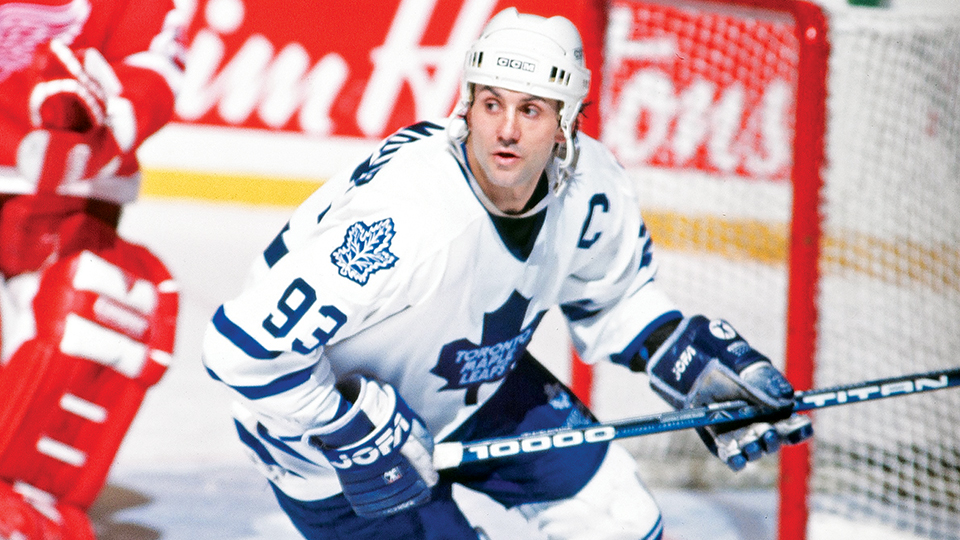Each day from now until the Winter Classic, Sportsnet will count down the greatest Toronto Maple Leafs of all time.
Tom Watt’s directive to trainer Brian Papineau was clear. “No more high numbers,” the Maple Leafs coach told the guy in charge of the sweaters. And then GM Cliff Fletcher closed a franchise-shaping deal with Calgary, one that brought Doug Gilmour to Toronto.
Gilmour wasn’t all that comfortable with Watt’s preference for old-school numbers. “At first they gave me No. 14, when the trade was made,” Gilmour says. “I wore 14 as a kid. I liked the number. But there was no way I was going to wear it in Toronto.”
The Leafs’ policy of never retiring numbers has freighted a few with expectations and inevitably draws comparisons between a legend and the player who’d go on to wear it later. No number would match the burdens of No. 14, particularly if its wearer was coming in billed as a franchise centre. It’s easy to understand why Gilmour wasn’t keen to wear Dave Keon’s old number.
Watt relented and No. 93 was sewn on the back of Gilmour’s sweater and, to this day, thousands of replicas that pay tribute to a player who left his indelible mark on the city in a brief but spectacular time during the ’90s.
In retrospect, No. 14 might have been a good fit for Gilmour, because, for a time, he more than played up to Keon’s standard. Their careers in Toronto stand in sharp contrast: Keon played 1,020 regular-season games in all, Gilmour only 393 regular-season games with the Leafs, less than a third of his NHL career; Keon was a gifted skater and Gilmour a slashing rink rat; Keon came up through the St. Michael’s program, moving directly to the Leafs at 20, and Gilmour began his career in St. Louis, won a Cup in Calgary and went on to play for four other teams after his stint in Toronto.
Yet, just as people think of Keon as a Leaf despite his seasons in the World Hockey Association and with Hartford in the NHL late in his career, so do they think of Gilmour first and foremost in blue and white, mostly on account of the 1992–93 season. It’s a point not worth arguing: No Toronto player has ever had a year to compare with Gilmour’s first full winter with the Leafs. The regular-season numbers are compelling enough: 32 goals and 95 assists for 127 points, the latter two Leafs records. They were, however, just a prelude to an even more impressive playoff run: 10 goals and 35 points (another team record) in 21 games that fell one short of taking Toronto to a Cup final against Montreal. “It was a special team and a special time,” Gilmour says. “Pat Burns took Montreal to a Final and won a Stanley Cup in New Jersey but he always said that ’93 team was his favourite.”
And Gilmour was its franchise player. Watching him during that run in ’93, you had to worry about his well-being. He was generously listed at five-foot-eleven and 175 lb., but in the playoff grind he paid a huge physical price. He had circles as black as pucks under his eyes. He looked gaunt. He played out from under a score of fresh bruises and welts, living up to his nickname, “Killer.” His personal highlight that spring came in the second overtime of game one against St. Louis in the conference semis. The puck came to Gilmour behind the Blues’ net and he held onto it for eight full agonizing seconds before he bait-and-switched goaltender Curtis Joseph for a goal that has been replayed 100,000 times.
Gilmour stayed on four more seasons in Toronto but no team matched the ’93 edition, and no moment matched any in the Leafs’ run that spring. And, truth be told, while he remained a great player, Gilmour left something behind in getting so close to the Stanley Cup.
He envisioned playing in Toronto the rest of his career and let Cliff Fletcher know his feelings in the spring of ’97. But the GM told him that with the team dropping out of the playoffs, ownership wanted to make a move and Gilmour was dealt to New Jersey. Unlike Keon, Gilmour had a chance to finish his career in Toronto but it couldn’t have been more short-lived: Montreal sent him back to the Leafs in the spring of 2003 but he suffered a knee injury 4:51 into his return. He would never play again. “I hoped that I was going to be able to play on a third line or a role like that on a veteran team that would make a run deep,” Gilmour says. “It wasn’t meant to be.”
No matter. For a short stretch, no one had ever been better in a Toronto sweater. During that time he could have worn any number and not suffered by comparison. And only a rookie with no sense of history is ever going to ask the trainer to sew No. 93 on his Leafs sweater.

